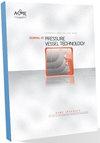无限大板受压混合模式倾斜表面裂纹的约束效应及断裂模式研究
IF 1.4
4区 工程技术
Q4 ENGINEERING, MECHANICAL
Journal of Pressure Vessel Technology-Transactions of the Asme
Pub Date : 2023-07-11
DOI:10.1115/1.4062952
引用次数: 0
摘要
研究了I-II-III混合型倾斜表面裂纹在压缩作用下的应力场、约束效应和裂纹尖端的断裂模式转变。定量研究了几何形态(相对裂纹深度和纵横比)、摩擦系数和双轴尺度因子对应力强度因子(KII和KIII)及面内约束参数t应力的影响,比较了不同裂纹倾角下拉压作用下的应力场;并根据广义最大切向应力准则(GMTS)分析了倾斜表面裂纹沿裂纹前缘特殊位置的破坏模式。相对裂纹深度对应力强度因子和t应力的影响较小,而纵横比对应力强度因子和t应力的影响显著。摩擦系数降低了应力强度因子的大小,增大了t应力的大小,裂纹倾角越大,裂纹倾角大于30°时效果越明显。拉伸和压缩作用下裂纹尖端周围的应力分布完全不同。在自由面处,裂纹形成面内剪切II型滑动裂纹,在裂纹最深处,裂纹在压缩作用下形成面外剪切III型撕裂裂纹。本文章由计算机程序翻译,如有差异,请以英文原文为准。
Investigation Of Constraint Effect And Fracture Mode For Mixed Mode Inclination Surface Crack In Infinite Plate Under Compression
The stress field, constraint effect and fracture mode transition at crack tip of mixed mode I-II-III inclination surface crack under compression have been investigated. The effects of geometrical configurations (relative crack depth and aspect ratio), friction coefficient and biaxial scale factor on stress intensity factor (KII and KIII) and in-plane constraint parameter T-stress are quantitatively studied, the stress field at different crack inclination angles under tension and compression are compared, and the failure mode at special locations along crack front of inclination surface crack are analyzed according to the generalized maximum tangential stress criterion(GMTS). The relative crack depth has slight effect on stress intensity factor and T-stress, and aspect ratio has significant effect on stress intensity factor and T-stress. The friction coefficient decreases the magnitude of stress intensity factor and increases the magnitude of T-stress, the greater the crack inclination angle is, the more pronounced the effect is when crack inclination angle greater than 30°. The stress distribution around crack tip under tension and compression is completely different. At free surface, the crack will failure in-plane shear mode II sliding crack, and at the deepest part of crack, the crack will start as an out-plane shear mode III tearing crack under compression.
求助全文
通过发布文献求助,成功后即可免费获取论文全文。
去求助
来源期刊
CiteScore
2.10
自引率
10.00%
发文量
77
审稿时长
4.2 months
期刊介绍:
The Journal of Pressure Vessel Technology is the premier publication for the highest-quality research and interpretive reports on the design, analysis, materials, fabrication, construction, inspection, operation, and failure prevention of pressure vessels, piping, pipelines, power and heating boilers, heat exchangers, reaction vessels, pumps, valves, and other pressure and temperature-bearing components, as well as the nondestructive evaluation of critical components in mechanical engineering applications. Not only does the Journal cover all topics dealing with the design and analysis of pressure vessels, piping, and components, but it also contains discussions of their related codes and standards.
Applicable pressure technology areas of interest include: Dynamic and seismic analysis; Equipment qualification; Fabrication; Welding processes and integrity; Operation of vessels and piping; Fatigue and fracture prediction; Finite and boundary element methods; Fluid-structure interaction; High pressure engineering; Elevated temperature analysis and design; Inelastic analysis; Life extension; Lifeline earthquake engineering; PVP materials and their property databases; NDE; safety and reliability; Verification and qualification of software.

 求助内容:
求助内容: 应助结果提醒方式:
应助结果提醒方式:


